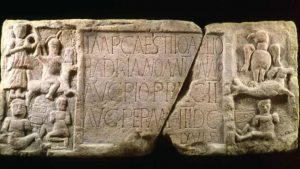Historical Breakthrough: Hidden text uncovered on ancient Roman sculpture with Analytik’s raman analytical technology
Dr Louisa Campbell of the University of Glasgow has now completed her Paints and Pigments in the Past (PPIP) project in her role as Postdoctoral Fellow in Archaeology, a project part-funded by Historic Environment Scotland’s Archaeology Programme.

Credit: Hunterian Museum/ University of Glasgow
In a recent interview for BBC Radio Scotland, Dr Campbell describes how she used X-ray Florescence and Raman Spectrometry analysis techniques to understand the elements and mineral compounds present on the sculptures to be able to reconstruct the colours that originally covered Scotland’s Antonine Wall’s distance stones.
Explaining her findings on the use of colour, she goes on to say: ”different reds pick out letters and dedications to the emperor and tell us who the legions were, as well as which legions were building the wall and how much of the wall they built”.

Credit: Herald Scotland
As part of her research, Dr Campbell utilised the SciAps Inspector Raman® handheld materials identification system, provided by Analytik. The unique instrument enables one micron Raman material discrimination, which can increase the number of samples identified by eliminating unwanted samples and background fluorescence.
When asked in the interview whether her research makes a case for re-examining other historical sculptures and artefacts, she concluded: “if we re-imagine and re-calibrate our thinking about these sculptures to really let us understand, we can go back and understand other sculptures as to whether they had similar of different colours on them”.


